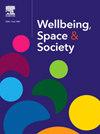Gender differences in subjective wellbeing in Japan: An intersectionality approach
IF 2.2
Q2 GEOGRAPHY
引用次数: 0
Abstract
Aims
Studies on gender differences in wellbeing often use narrowly defined wellbeing measures and only focus on overall comparison of men and women. This study examined gender differences in diverse wellbeing metrics across various subgroups.
Method
Data were obtained from the Nikkei Gross Domestic Wellbeing Survey—a quarterly survey on wellbeing among a nationally representative sample of people in Japan who are ≥15 years old (from 2021 to 2023; n = 9080). Our wellbeing outcomes included life satisfaction, happiness, the human flourishing domains, balance and harmony, calmness, and interdependent happiness. Gender differences in mean wellbeing scores (men minus women) were computed in the overall sample and within each demographic subgroup, including age groups, household income levels, educational attainment, employment status, family structure, and residency.
Result
Overall, women scored higher in wellbeing metrics than men (e.g., the gap in mean life satisfaction: 0.55, 95% Confidence Interval [CI]: 0.47 to 0.64). This trend persisted across most subgroups, but there were no significant gender differences among teenagers (e.g., life satisfaction: −0.11, 95% CI: −0.53 to 0.32; composite flourishing score: −0.35, 95% CI: −2.14 to 1.42), individuals in their twenties (e.g., life satisfaction: 0.16, 95% CI: −0.08 to 0.41; composite flourishing score: 0.07, 95% CI: −0.97 to 1.11), and unmarried individuals with children (life satisfaction: −0.20, 95% CI: −0.84 to 0.45; composite flourishing score: −0.87, 95% CI: −3.46 to 1.72).
Conclusions
While women generally reported higher wellbeing, certain subgroups exhibited unique patterns. Understanding these dynamics can inform targeted interventions to promote equity in wellbeing across demographic groups.
日本主观幸福感的性别差异:一种交叉性方法
关于幸福的性别差异的研究通常使用狭义的幸福指标,只关注男性和女性的总体比较。这项研究考察了不同亚组中不同幸福指标的性别差异。数据来自日经国内幸福总值调查(Nikkei Gross Domestic Wellbeing survey),这是一项针对日本15岁以上具有全国代表性样本的幸福感季度调查(从2021年到2023年;N = 9080)。我们的幸福结果包括生活满意度、幸福感、人类繁荣领域、平衡与和谐、平静和相互依赖的幸福感。平均幸福分数(男性减去女性)的性别差异在整个样本和每个人口统计亚组中计算,包括年龄组、家庭收入水平、教育程度、就业状况、家庭结构和居住地。结果总体而言,女性在幸福指标上的得分高于男性(例如,平均生活满意度差距为0.55,95%置信区间[CI]: 0.47至0.64)。这种趋势在大多数亚组中持续存在,但在青少年中没有显著的性别差异(例如,生活满意度:- 0.11,95% CI: - 0.53至0.32;综合繁荣得分:- 0.35,95% CI: - 2.14至1.42),20多岁的个体(例如,生活满意度:0.16,95% CI: - 0.08至0.41;综合繁荣得分:0.07,95% CI: - 0.97至1.11),未婚有子女的个体(生活满意度:- 0.20,95% CI: - 0.84至0.45;综合繁荣评分:−0.87,95% CI:−3.46 ~ 1.72)。结论:虽然女性普遍表现出更高的幸福感,但某些亚群体表现出独特的模式。了解这些动态可以为有针对性的干预措施提供信息,以促进各人口群体的福祉公平。
本文章由计算机程序翻译,如有差异,请以英文原文为准。
求助全文
约1分钟内获得全文
求助全文
来源期刊

Wellbeing Space and Society
Social Sciences-Social Sciences (miscellaneous)
CiteScore
2.70
自引率
0.00%
发文量
46
审稿时长
124 days
 求助内容:
求助内容: 应助结果提醒方式:
应助结果提醒方式:


